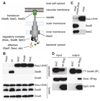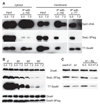pH sensing by intracellular Salmonella induces effector translocation
- PMID: 20395475
- PMCID: PMC6485629
- DOI: 10.1126/science.1189000
pH sensing by intracellular Salmonella induces effector translocation
Abstract
Salmonella enterica is an important intracellular bacterial pathogen of humans and animals. It replicates within host-cell vacuoles by delivering virulence (effector) proteins through a vacuolar membrane pore made by the Salmonella pathogenicity island 2 (SPI-2) type III secretion system (T3SS). T3SS assembly follows vacuole acidification, but when bacteria are grown at low pH, effector secretion is negligible. We found that effector secretion was activated at low pH from mutant strains lacking a complex of SPI-2-encoded proteins SsaM, SpiC, and SsaL. Exposure of wild-type bacteria to pH 7.2 after growth at pH 5.0 caused dissociation and degradation of SsaM/SpiC/SsaL complexes and effector secretion. In infected cells, loss of the pH 7.2 signal through acidification of host-cell cytosol prevented complex degradation and effector translocation. Thus, intravacuolar Salmonella senses host cytosolic pH, resulting in the degradation of regulatory complex proteins and effector translocation.
Figures




Comment in
-
Microbiology. Salmonella's safety catch.Science. 2010 May 21;328(5981):981-2. doi: 10.1126/science.1190758. Science. 2010. PMID: 20489009 No abstract available.
References
Publication types
MeSH terms
Substances
Grants and funding
LinkOut - more resources
Full Text Sources
Other Literature Sources
Miscellaneous

